ITF Black Belt Patterns
What are patterns?

A pattern is a logical sequence of fundamental movements which represent either attack or defence against one or more imaginary opponents.
There are a total of twenty-four patterns in Taekwon-do. The name of the pattern, the number of movements, and the diagrammatic symbol of each pattern symbolize either heroic figures in Korean history or instances relating to historical events.
When a pattern is completed the practioner should shout its name. The meaning and interpretation of each pattern will be found on its specific page.
Benefits of Practicing Patterns
- To practice many fundamental movements.
- To develop sparring techniques.
- To improve the flexibility of movements.
- To master body shifting.
- To build muscles (with slow motion techniques for example) and improve breathing techniques.
- To develop fluid and smooth motions.
- To gain rhythmical movements (through practice).
Things to remember while performing patterns:
- The pattern should begin and end at exactly the same spot. This will indicate the performer's accuracy.
- Correct posture and facing must be maintained at all times.
- Muscles of the body should be either tensed or relaxed at the proper critical moments in the exercise.
- The exercise should be performed in a rhythmic movement with an absence of stiffness.
- Movement should be accelerated or decelerated according to the instructions in this book.
- Each pattern should be perfected before moving to the next.
- Students should know the purpose of each movement.
- Students should perform each movement with realism.
- Attack and defence techniques should be equally distributed among right and left hands and feet.